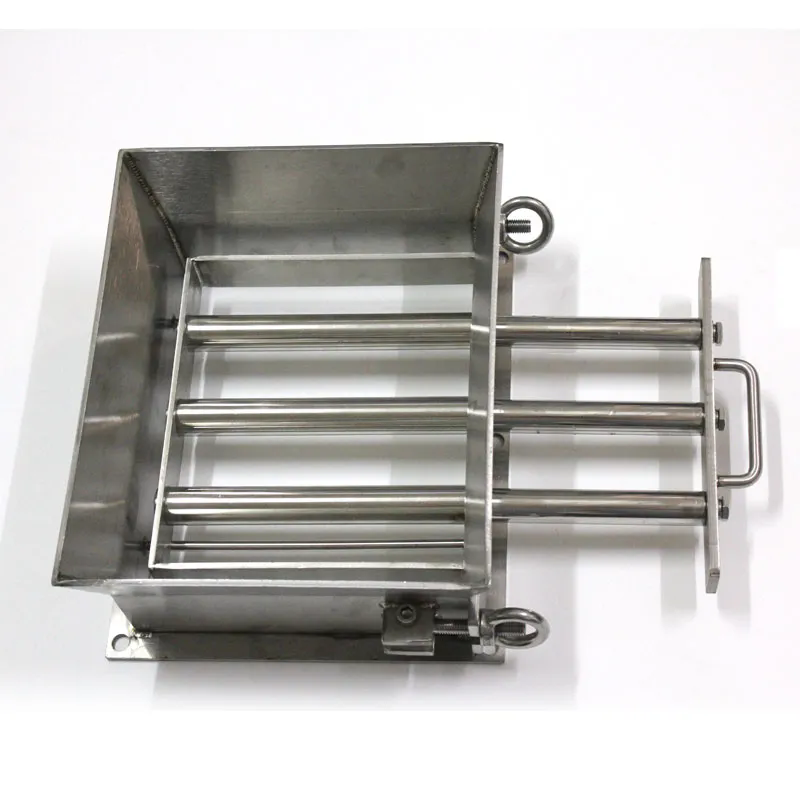What Makes Magnetic Separation Grids an Essential Tool for Industrial Applications?
2024-11-08
In many industrial and manufacturing processes, the need for purity and cleanliness of materials is critical. Whether it’s food production, pharmaceuticals, or plastics, contaminants in raw materials can compromise product quality and safety. One highly effective tool used to ensure the removal of these unwanted particles is magnetic separation grids. But what exactly are magnetic separation grids, and why are they so essential in various industries? Let’s take a deeper look.
What Are Magnetic Separation Grids?
Magnetic separation grids are powerful filtration systems designed to remove ferrous (magnetic) materials from bulk products. Typically made of strong magnets encased in a grid formation, these grids are strategically placed in the flow of material to attract and collect magnetic contaminants, ensuring that the product is free from any ferrous metal debris.
These grids are often used in industries dealing with powders, grains, liquids, or other bulk materials. They work by creating a magnetic field that attracts and holds ferrous particles as the material flows through or over the grid. This simple yet effective mechanism ensures that the end product remains clean, safe, and of high quality.
Why Are Magnetic Separation Grids Important?
1. Enhanced Product Safety and Quality
One of the main reasons magnetic separation grids are so important is their ability to protect product integrity. In industries such as food processing or pharmaceuticals, contamination by metal particles can pose serious risks to consumer health and safety. Magnetic separation grids act as an additional line of defense, removing harmful metal particles from the product before it reaches the consumer.
These grids ensure that even the smallest ferrous contaminants are captured and removed, maintaining the quality and safety of the end product.
2. Improved Operational Efficiency
The use of magnetic separation grids can also enhance production efficiency. By reducing the risk of metal contamination, manufacturers avoid product rejections, costly recalls, and damage to machinery. Ferrous metal debris, if left unchecked, can cause damage to processing equipment like mixers, mills, or conveyors. By preventing this, magnetic separation grids contribute to the longevity of your machinery and help maintain smooth production processes.
Additionally, many magnetic separation systems are designed for easy cleaning and maintenance, which allows for minimal downtime and seamless operations.
3. Cost-Effective Solution
While the initial investment in a magnetic separation grid might seem like a significant cost, it’s important to consider the long-term savings. Magnetic grids reduce the risk of machine wear and product recalls, both of which can result in hefty financial losses. Moreover, the relatively low maintenance cost of magnetic separation systems makes them a cost-effective option in the long run.
4. Versatility Across Different Industries
Magnetic separation grids are used in a variety of industries where contamination control is essential. Here are a few examples:
- Food Industry: Magnetic grids are commonly used to ensure that raw ingredients like flour, sugar, or spices are free from metallic contaminants.
- Pharmaceutical Industry: In the production of medicines or supplements, magnetic grids help ensure that products are free from iron or steel contaminants.
- Plastics and Rubber: These grids are often used in plastic manufacturing to prevent metal contaminants from damaging machinery or degrading product quality.
- Recycling: Magnetic separation grids are useful in recycling facilities to remove metal debris from recyclable materials, improving the quality of the final product.
5. Customizable Designs
Magnetic separation grids come in a range of designs and sizes to meet specific needs. They can be tailored to fit different types of production lines or processing systems, whether they are installed in chutes, hoppers, or processing tanks. You can choose the strength of the magnets, the grid size, and the material used to best suit your application. This level of customization ensures that your magnetic separation system will work effectively, regardless of the material being processed.
6. Easy Installation and Maintenance
Magnetic separation grids are designed to be easily integrated into existing production lines. Most grids can be simply dropped into place, without the need for major modifications to machinery. Furthermore, many grids are designed for easy cleaning. A well-maintained magnetic grid will continue to perform at high levels for years, making it a low-maintenance, high-efficiency solution for contamination control.
How Do Magnetic Separation Grids Work?
Magnetic separation grids operate by creating a strong magnetic field that attracts ferrous particles as material flows through the grid. These grids are typically composed of high-strength magnets arranged in a series of bars or grids. When ferrous materials like steel, iron, or other magnetic metals come in contact with the grid, they are captured by the magnetic field and held in place until they are manually or automatically removed during cleaning.
The design of the grid ensures that even the smallest metal particles are captured, offering high levels of contamination control. The process is simple, but its effectiveness in maintaining product purity is unmatched.
Conclusion
Magnetic separation grids are an essential tool in industries where product purity, safety, and machine protection are a priority. Their ability to efficiently remove ferrous contaminants, enhance product quality, and improve operational efficiency makes them invaluable in various sectors, from food production to recycling. With customizable designs and easy maintenance, magnetic separation grids are an investment that ensures long-term reliability and cost savings.
If you're looking to maintain the highest standards in your production processes, integrating magnetic separation grids into your system could be one of the smartest decisions you make.



